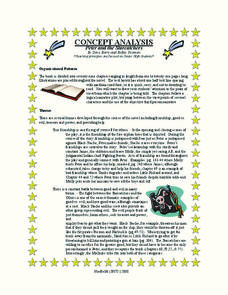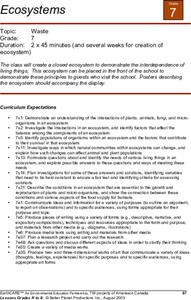Curated OER
Peter and the Starcatchers: Concept Analysis
Are you preparing to teach Peter and the Starcatchers? If so, you'll want to take a look at this analysis of the text, which describes plot and literary elements in-depth and explores potential implications related to diversity and...
Curated OER
Worksheet 3/7 A Gaggle of Collective Nouns
Encourage your class to identify the correct usage of collective nouns in sentences with this activity. Given three choices, with the collective nouns circled in each possible choice, class members choose the sentence in which the...
Curated OER
What Does Respect Look Like at Home?
Fourth graders conceptualize the value of respect for self, and give examples and non-examples. They describe how things could have been done differently within the family or the community for non-examples. Students conceptualize the...
Poetry Society
Simile and Metaphor
Young poets use word cards to prompt a metaphor poem comparing to very dissimilar items.
Carolina K-12
Are You a Democrat or a Republican? Are You Really?
Have new or soon-to-be voters examine different political parties and their platforms as they figure out which one aligns most with their beliefs. After taking a few online quizzes, students split into pairs to discuss and then...
Constitutional Rights Foundation
If Men Were Angels: Teaching the Constitution With the Federalist Papers
Much like the methods of group work, the writers of the Federalist Papers worked together to advocate for their viewpoints against the anti-federalists. The resource enables learners to break into small groups and conduct research before...
Curated OER
Making Comparisons- School-Home Links
In this grammar worksheet, 2nd graders and parents read about making comparisons between unlike things and the use of similes. They underline the two things that are being compared in 4 sentences. There is a place for both the student...
Curated OER
Through the Eyes of an Owl
Students describe vertebrates in terms of observable body parts and characteristics and describe life cycles of familiar organisms. They identify familiar organisms as part of a food chain or food web and describe their feeding...
Pennsylvania Department of Education
Animal Classes and Their Ecosystems
Students explore animal characteristics by participating in an environment identification activity. In this animal habitat lesson plan, students discuss a range of different wild life and the ecosystems that they are a part of. Students...
Curated OER
Bacteria: The good, the bad, the ugly
Seventh graders conduct an experiment. In this bacteria lesson, 7th graders list living and nonliving things and brainstorm the characteristics they share. Students are divided into two groups where they put samples of hand...
Curated OER
A House for Me- Ocean Environments
Students explore ocean environments. In this ocean environment lesson, students identify the things ocean animals need for survival. Students use KWL charts and search the Internet collecting information about ocean habitats....
Curated OER
Email Riddles
Students compose riddles that are shared in a chat session conducted on their local school network. Students create clues that describe a specific animal or object. They watch as their words are typed onto the chat screen and sent to the...
Curated OER
Wonderful Worms
Students identify living and non-living things and explain the importance of earthworms to the soil. They name some basic facts about earthworms, recognize basic worm vocabulary words and demonstrate vermicomposting techniques.
Curated OER
The Civil War
Learners are able to describe all of the Civil War terms. They are able to wonder why things happened. Students are able to tell that the United States used to be two countries.
Curated OER
Ecosystems
Seventh graders create a closed ecosystem and place it where is it visible to others in the school. They label it with posters describing the interdependence of living things in the ecosystem. They discuss what might happen to the...
Curated OER
Pond Water Survey
Students identify and describe various organisms living in a pond water environment. They describe the characteristics of living things. Students compare and contrast organisms created by asexual reproduction and sexual reproduction....
Curated OER
Role Models
Students consider what makes a role model. In this positive qualities lesson, students read and discuss several books that have characters describing themselves in a positive manner. Students illustrate a self portrait, remembering to...
Curated OER
Minerals of the Earth
Students learn and practice identifying Earth's minerals and their properties. Working in small groups, they evaluate minerals. This is a well-described lesson, which students enjoy.
Curated OER
Traces: Historic Archaeology
Students list at least five different kinds of artifacts archaeologists have found in U.S. excavations. They cite artifacts when describing life at a particular archaeological site.
Curated OER
Got Plants
Second graders discover that all living things need food in order to live. In groups, they examine the interconnectedness between animals and plants. They identify which animals eat plants to survive and which animals eat animals that...
Curated OER
Salmon Scavenger Hunt
Students go on a salmon scavenger hunt to find out about threats to salmon populations. They gather information about some of the reasons wild salmon have gone from such incredible abundance to relative scarcity, and about some of the...
Curated OER
"Garden Springs Gardeners"
First graders ponder the question of how plants help their lives. They observe and compare properties of several different plants. Differentiate between living organisms and nonliving objects.
Curated OER
Exploring the Great Salt Lake
Third graders participate in a scavenger hunt, looking for things that are unique about the ecosystem in and around the lake. They observe and describe a variety of habitats and distinguish living and nonliving elements of...
Curated OER
Earth Book
After viewing a teacher-led demonstration on a variety of landforms of the Earth, 1st graders create an Earth book. This nicely-done hands-on lesson has students produce books that describe, in pictures and words, different aspects of...























